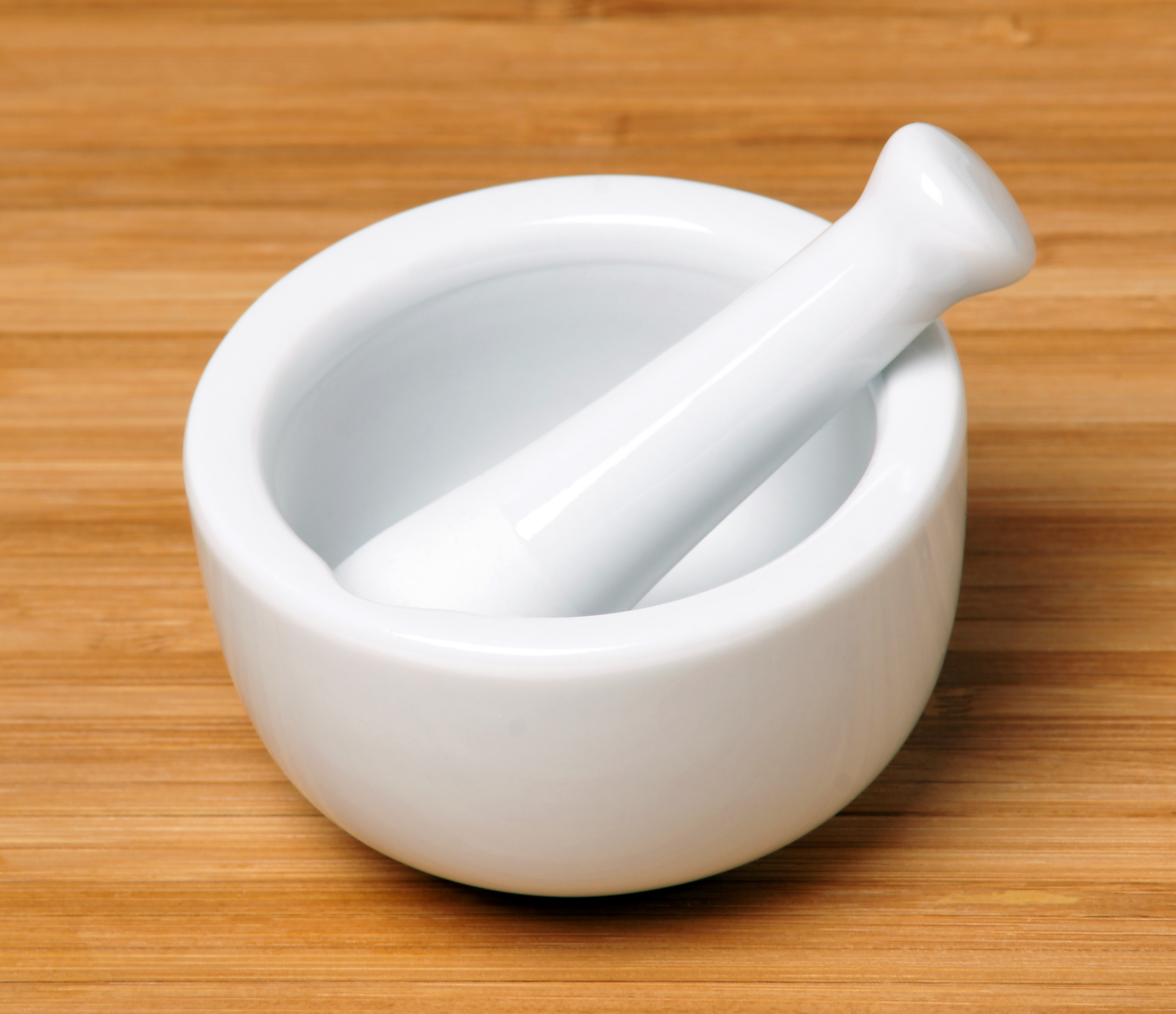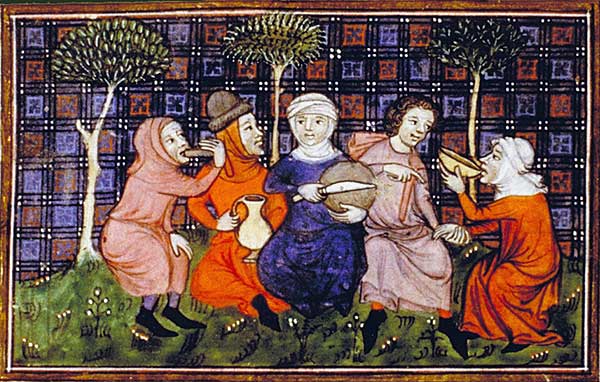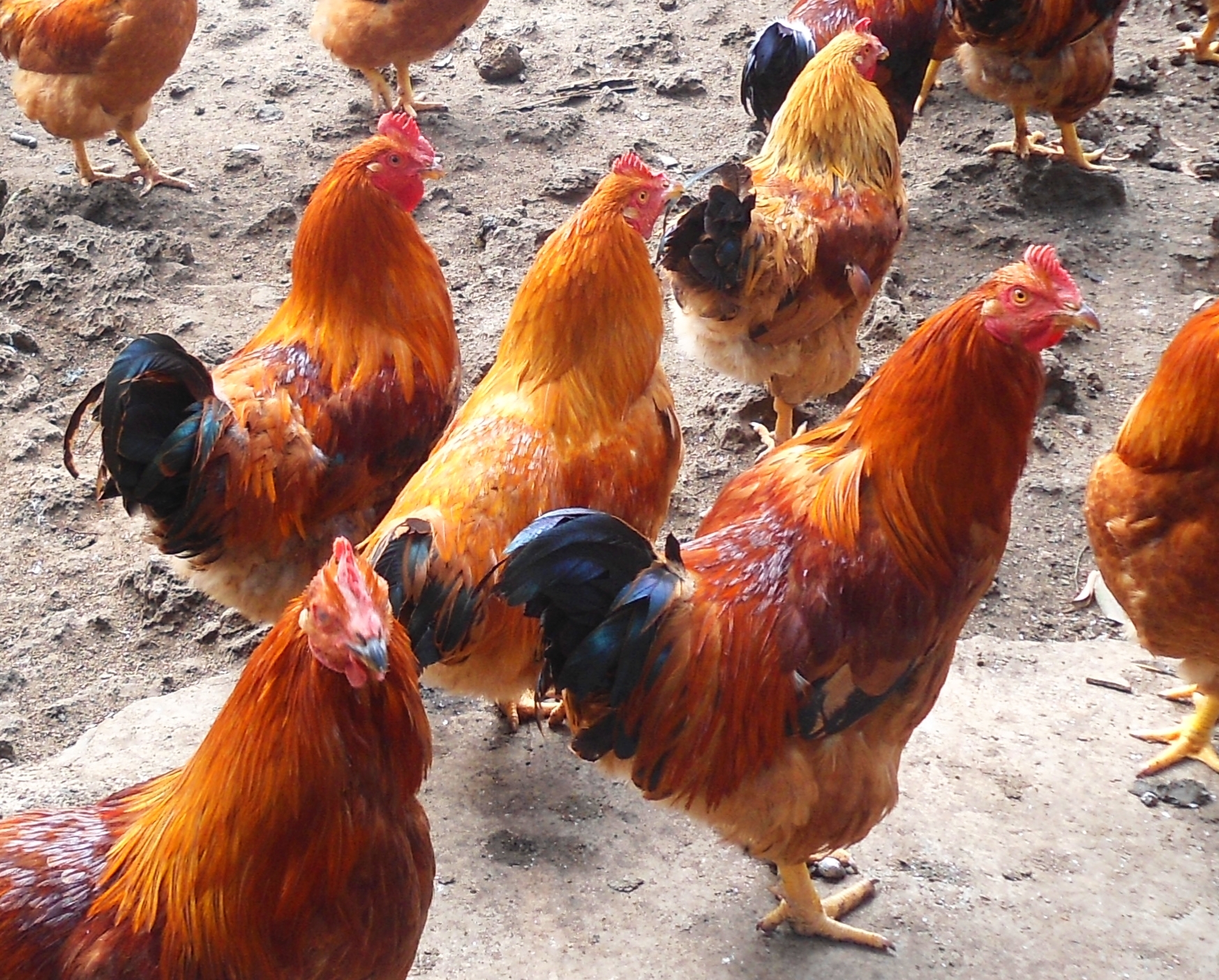|
Mortis (food)
A mortis, also spelt mortrose, mortress, mortrews, or mortruys, was a sweet pâté of a meat such as chicken or fish, mixed with ground almonds, made in Medieval, Tudor and Elizabethan era England. It is known from one of England's earliest cookery books, ''The Forme of Cury'' (1390), and other manuscripts. Dish A Tudor mortis recipe for chicken is given in ''The Good Huswifes Jewell'', an English cookery book of 1585 by Thomas Dawson. He instructs: The dish consists of meat, such as chicken or fish, boiled and pounded with blanched almonds and milk into a smooth paste. This is then cooked gently with sugar. An earlier recipe for "mortrose of fyshe" (fish mortis) is given in the 1390 cookery book, ''The Forme of Cury'', written for King Richard's cooks. It called for houndfish, haddock, or cod, using the liver as well as the flesh, mixed with milk, white breadcrumbs and sugar. A similar recipe appeared in ''Gentyll Manly Cokere'' in the Pepys Manuscript 1047, dating from aro ... [...More Info...] [...Related Items...] OR: [Wikipedia] [Google] [Baidu] |
Pâté
''Pâté'' ( , , ) is a paste, pie or loaf filled with a forcemeat. Common forcemeats include ground meat from pork, poultry, fish or beef; fat, vegetables, herbs, spices and either wine or brandy (often cognac or armagnac). It is often served on or with bread or crackers. Pâté can be served either hot or cold, but it is considered to develop its best flavors after a few days of chilling. History Pâté is believed to have originated in medieval France. The word pâté derives from the Old French word patete, which referred to any sort of paste. It was used to refer to the filling of any sort of pastry. Pâté is believed to have developed as a means of preserving the meat of game that could not be kept fresh. In the 16th century, it became popular with French royalty, and in the 17th century, the first recorded pâtés appeared. The first pâtés were made from a mixture of beef and chicken with various spices. By the 19th century, pâté was a staple in French cuisine. ... [...More Info...] [...Related Items...] OR: [Wikipedia] [Google] [Baidu] |
Scyliorhinus
''Scyliorhinus'' is a genus of catsharks in the family Scyliorhinidae. This genus is known in the fossil records from the Cretaceous period, late Albian age to the Pliocene epoch.Carrier, J. C.; Musick, J. A. & Heithaus, M. R. (2004)''Biology of Sharks and Their Relatives'' Species There are currently 16 recognized species in this genus: * ''Scyliorhinus boa'' Goode & T. H. Bean, 1896 (boa catshark) * ''Scyliorhinus cabofriensis'' K. D. A. Soares, U. L. Gomes & M. R. de Carvalho, 2016Soares, K.D.A., Gomes, U.L. & De Carvalho, M.R. (2016): Taxonomic review of catsharks of the ''Scyliorhinus haeckelii'' group, with the description of a new species (Chondrichthyes: Carcharhiniformes: Scyliorhinidae). ''Zootaxa, 4066 (5): 501-534.'' * ''Scyliorhinus canicula'' (Linnaeus, 1758) (small-spotted catshark) * ''Scyliorhinus capensis'' ( J. P. Müller & Henle, 1838) (yellowspotted catshark) * ''Scyliorhinus cervigoni'' Maurin & M. Bonnet, 1970 (West African catshark) * ''Scyliorhinus ... [...More Info...] [...Related Items...] OR: [Wikipedia] [Google] [Baidu] |
Medieval Cuisine
Medieval cuisine includes foods, eating habits, and cooking methods of various European cultures during the Middle Ages, which lasted from the fifth to the fifteenth century. During this period, diets and cooking changed less than they did in the early modern period that followed, when those changes helped lay the foundations for modern European cuisine. Cereals remained the most important staple during the Early Middle Ages as rice was introduced late, and the potato was only introduced in 1536, with a much later date for widespread consumption. Barley, oats, and rye were eaten by the poor. Wheat was for the governing classes. These were consumed as bread, porridge, gruel, and pasta by all of society's members. Cheese, fruits, and vegetables were important supplements to the cereal-based diet of the lower orders. Meat was more expensive and therefore more prestigious. Game, a form of meat acquired from hunting, was common only on the nobility's tables. The most prevalent butc ... [...More Info...] [...Related Items...] OR: [Wikipedia] [Google] [Baidu] |
English Cuisine
English cuisine encompasses the cooking styles, traditions and recipes associated with England. It has distinctive attributes of its own, but also shares much with wider British cuisine, partly through the importation of ingredients and ideas from the Americas, China, and India during the time of the British Empire and as a result of post-war immigration. Some traditional meals, such as bread and cheese, roasted and stewed meats, meat and game pies, boiled vegetables and broths, and freshwater and saltwater fish have ancient origins. The 14th-century English cookbook, the ''Forme of Cury'', contains recipes for these, and dates from the royal court of Richard II. English cooking has been influenced by foreign ingredients and cooking styles since the Middle Ages. Curry was introduced from the Indian subcontinent and adapted to English tastes from the eighteenth century with Hannah Glasse's recipe for chicken "currey". French cuisine influenced English recipes throughout ... [...More Info...] [...Related Items...] OR: [Wikipedia] [Google] [Baidu] |
Ramekin
A ramekin (, ; also spelled ramequin) is a small dish used for culinary purposes. Name The term is derived from the French ', a cheese- or meat-based bowl baked in a small mould. The French term is in turn derived from early modern Dutch ', which translated to 'toast' or 'roasted minced meat', itself apparently from ''ram'' 'battering ram' + ''-kin'' 'diminutive', but it is unclear why.Oxford English Dictionary, Third Edition, 200''s.v.''/ref> Usage With a normal capacity of approximately , ramekins are commonly used for preparing and serving individual portions of a variety of dishes, including crème brûlée, French onion soup, molten chocolate cake, moin moin, cheese or egg dishes, poi, macaroni and cheese, lasagna, potted shrimps, ice cream, soufflé, baked cocottes, crumbles, chakra póngal, or scallops, or used to serve side garnishes and condiments alongside an entrée An entrée (, ; ) in modern French table service and that of much of the English-speaking world ... [...More Info...] [...Related Items...] OR: [Wikipedia] [Google] [Baidu] |
Ginger
Ginger (''Zingiber officinale'') is a flowering plant whose rhizome, ginger root or ginger, is widely used as a spice A spice is a seed, fruit, root, bark, or other plant substance primarily used for flavoring or coloring food. Spices are distinguished from herbs, which are the leaves, flowers, or stems of plants used for flavoring or as a garnish. Spice ... and a folk medicine. It is a herbaceous perennial plant, perennial which grows annual pseudostems (false stems made of the rolled bases of leaves) about one meter tall bearing narrow leaf blades. The inflorescences bear flowers having pale yellow petals with purple edges, and arise directly from the rhizome on separate shoots. Ginger is in the family (taxonomy), family Zingiberaceae, which also includes turmeric (''Curcuma longa''), cardamom (''Elettaria cardamomum''), and galangal. Ginger originated in Maritime Southeast Asia and was likely domesticated first by the Austronesian peoples. It was transported with ... [...More Info...] [...Related Items...] OR: [Wikipedia] [Google] [Baidu] |
Yolk
Among animals which produce eggs, the yolk (; also known as the vitellus) is the nutrient-bearing portion of the egg whose primary function is to supply food for the development of the embryo. Some types of egg contain no yolk, for example because they are laid in situations where the food supply is sufficient (such as in the body of the host of a parasitoid) or because the embryo develops in the parent's body, which supplies the food, usually through a placenta. Reproductive systems in which the mother's body supplies the embryo directly are said to be matrotrophic; those in which the embryo is supplied by yolk are said to be lecithotrophic. In many species, such as all birds, and most reptiles and insects, the yolk takes the form of a special storage organ constructed in the reproductive tract of the mother. In many other animals, especially very small species such as some fish and invertebrates, the yolk material is not in a special organ, but inside the egg cell. As sto ... [...More Info...] [...Related Items...] OR: [Wikipedia] [Google] [Baidu] |
Sugar
Sugar is the generic name for sweet-tasting, soluble carbohydrates, many of which are used in food. Simple sugars, also called monosaccharides, include glucose, fructose, and galactose. Compound sugars, also called disaccharides or double sugars, are molecules made of two bonded monosaccharides; common examples are sucrose (glucose + fructose), lactose (glucose + galactose), and maltose (two molecules of glucose). White sugar is a refined form of sucrose. In the body, compound sugars are hydrolysed into simple sugars. Longer chains of monosaccharides (>2) are not regarded as sugars, and are called oligosaccharides or polysaccharides. Starch is a glucose polymer found in plants, the most abundant source of energy in human food. Some other chemical substances, such as glycerol and sugar alcohols, may have a sweet taste, but are not classified as sugar. Sugars are found in the tissues of most plants. Honey and fruits are abundant natural sources of simple sugars. Suc ... [...More Info...] [...Related Items...] OR: [Wikipedia] [Google] [Baidu] |
Fire
Fire is the rapid oxidation of a material (the fuel) in the exothermic chemical process of combustion, releasing heat, light, and various reaction Product (chemistry), products. At a certain point in the combustion reaction, called the ignition point, flames are produced. The ''flame'' is the visible portion of the fire. Flames consist primarily of carbon dioxide, water vapor, oxygen and nitrogen. If hot enough, the gases may become ionized to produce Plasma (physics), plasma. Depending on the substances alight, and any impurities outside, the color of the flame and the fire's Intensity (heat transfer), intensity will be different. Fire in its most common form can result in conflagration, which has the potential to cause physical damage through burning. Fire is an important process that affects ecological systems around the globe. The positive effects of fire include stimulating growth and maintaining various ecological systems. Its negative effects include hazard to life and pr ... [...More Info...] [...Related Items...] OR: [Wikipedia] [Google] [Baidu] |
Pork
Pork is the culinary name for the meat of the domestic pig (''Sus domesticus''). It is the most commonly consumed meat worldwide, with evidence of pig husbandry dating back to 5000 BCE. Pork is eaten both freshly cooked and preserved; curing extends the shelf life of pork products. Ham, gammon, bacon, and sausage are examples of preserved pork. Charcuterie is the branch of cooking devoted to prepared meat products, many from pork. Pork is the most popular meat in the Western world, particularly in Central Europe. It is also very popular in East and Southeast Asia ( Mainland Southeast Asia, Philippines, Singapore, and East Timor). The meat is highly prized in Asian cuisines, especially in Mainland China, for its fat content and texture. Some religions and cultures prohibit pork consumption, notably Islam and Judaism. History Pigs were domesticated in Mesopotamia around 13,000 BC. Charcuterie is the branch of cooking devoted to prepared meat products such as ... [...More Info...] [...Related Items...] OR: [Wikipedia] [Google] [Baidu] |
Capon
A capon (from la, cāpō, genitive ''cāpōnis'') is a cockerel (rooster) that has been castrated or neutered, either physically or chemically, to improve the quality of its flesh for food, and, in some countries like Spain, fattened by forced feeding. History The origins of caponised chickens are contested. They were known in ancient China as well as in ancient Greece and ancient Rome. An early record of caponisation is found under the Roman Republic: the Lex Faunia of 162 BC forbade fattening hens to conserve grain rations, so the Romans instead castrated roosters, which resulted in a doubling of size. It was also practiced later throughout medieval times, with gastronomic texts describing capons as preferred poultry since the ordinary fowl of the farmyard was regarded as peasant fare and "popular malice crediting monks with a weakness for capons." France is internationally renowned for maintaining a strong caponisation tradition with widespread and established industr ... [...More Info...] [...Related Items...] OR: [Wikipedia] [Google] [Baidu] |
Saffron
Saffron () is a spice derived from the flower of ''Crocus sativus'', commonly known as the "saffron crocus". The vivid crimson stigma and styles, called threads, are collected and dried for use mainly as a seasoning and colouring agent in food. Although some doubts remain on its origin, it is believed that saffron originated in Iran. However, Greece and Mesopotamia have also been suggested as the possible region of origin of this plant. Saffron crocus slowly propagated throughout much of Eurasia and was later brought to parts of North Africa, North America, and Oceania. Saffron's taste and iodoform-like or hay-like fragrance result from the phytochemicals picrocrocin and safranal. It also contains a carotenoid pigment, crocin, which imparts a rich golden-yellow hue to dishes and textiles. Its recorded history is attested in a 7th-century BC Assyrian botanical treatise, and has been traded and used for thousands of years. In the 21st century, Iran produces some 90% of ... [...More Info...] [...Related Items...] OR: [Wikipedia] [Google] [Baidu] |










